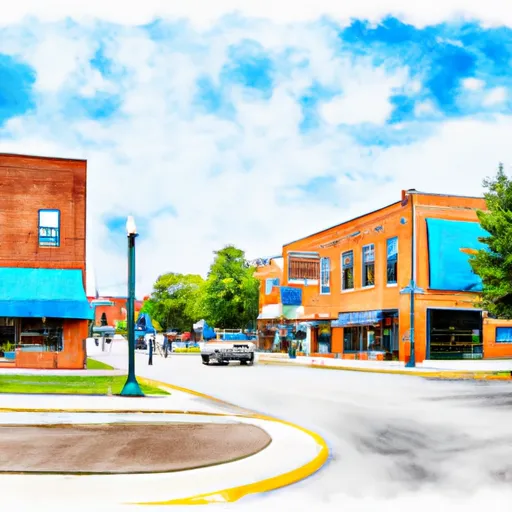-
 Snoflo Premium
Snoflo Premium
Get unlimited access to all our content
With no Ad interruptions! - Start Your Free Trial Login with existing account
Marysville
Eden Index
Climate
9.0
•
Recreation
3.5
•
Community
2.7
•
Safeguard
5.5/10

Marysville, Michigan is a charming city located in St. Clair County, along the eastern shores of the St. Clair River. The climate in Marysville is influenced by the Great Lakes, resulting in cool summers and cold winters. Average temperatures range from around 20°F (-7°C) in winter to 80°F (27°C) in summer. Precipitation is evenly distributed throughout the year, with occasional lake-effect snowfall during winter months.
Hydrologically, Marysville is situated along the St. Clair River, providing picturesque waterfront views and recreational opportunities. The river also supports a diverse ecosystem, with various fish species such as walleye, perch, and bass. Boating, fishing, and kayaking are popular outdoor activities for residents and visitors alike.
In addition to the river, Marysville boasts several parks and green spaces, offering numerous opportunities for outdoor recreation. The Marysville City Park features picnic areas, playgrounds, and walking trails, while Chrysler Beach Park offers a sandy shoreline for sunbathing and swimming. There are also multiple golf courses in the area for enthusiasts to enjoy. Overall, Marysville provides a serene and nature-rich environment for outdoor enthusiasts to explore and appreciate.
What is the Eden Index?
The Snoflo Eden Index serves as a comprehensive rating system for regions, evaluating their desirability through a holistic assessment of climate health, outdoor recreation opportunities, and natural disaster risk, acknowledging the profound impact of these factors on livability and well-being.
Climate Health Indicator (CHI): 9.0
Marysville receives approximately
834mm of rain per year,
with humidity levels near 77%
and air temperatures averaging around
9°C.
Marysville has a plant hardyness factor of
6, meaning
plants and agriculture in this region thrive during a short period during spring and early summer. Most
plants will die off during the colder winter months.
By considering the ideal temperature range, reliable water supplies, clean air, and stable seasonal rain or snowpacks, the Climate Health Indicator (CHI) underscores the significance of a healthy climate as the foundation for quality living.
A healthy climate is paramount for ensuring a high quality of life and livability in a region, fostering both physical well-being and environmental harmony. This can be characterized by ideal temperatures, reliable access to water supplies, clean air, and consistent seasonal rain or snowpacks.
Weather Forecast
Streamflow Conditions
St. Clair-Detroit
Area Rivers
St. Clair-Detroit
Snowpack Depths
St. Clair-Detroit
Reservoir Storage Capacity
St. Clair-Detroit
Groundwater Levels
Recreational Opportunity Index (ROI): 3.5
The Recreational Opportunity Index (ROI) recognizes the value of outdoor recreational options, such as parks, hiking trails, camping sites, and fishing spots, while acknowledging that climate plays a pivotal role in ensuring the comfort and consistency of these experiences.
Access to outdoor recreational opportunities, encompassing activities such as parks, hiking, camping, and fishing, is crucial for overall well-being, and the climate plays a pivotal role in enabling and enhancing these experiences, ensuring that individuals can engage in nature-based activities comfortably and consistently.
Camping Areas
| Campground | Campsites | Reservations | Toilets | Showers | Elevation |
|---|---|---|---|---|---|
| Two Creeks - Wheatley Provincial Park | 36 | 586 ft | |||
| North Park | 180 | 606 ft | |||
| Highlands - Wheatley Provincial Park | 75 | 589 ft | |||
| Middle Creek - Wheatley Provincial Park | 52 | 592 ft | |||
| Lakeport State Park | 280 | 603 ft | |||
| Sanilac County Park - Forester | 190 | 606 ft | |||
| Wagener County Park | 96 | 593 ft | |||
| Algonac State Park | 400 | 582 ft | |||
| Boosey Creek - Wheatley Provincial Park | 57 | 589 ft |
Nearby Fishing
Nearby Ski Areas
Catastrophe Safeguard Index (CSI):
The Catastrophe Safeguard Index (CSI) recognizes that natural disaster risk, encompassing floods, fires, hurricanes, and tornadoes, can drastically affect safety and the overall appeal of an area.
The level of natural disaster risk in a region significantly affects safety and the overall livability, with climate change amplifying these risks by potentially increasing the frequency and intensity of events like floods, fires, hurricanes, and tornadoes, thereby posing substantial challenges to community resilience and well-being.
Community Resilience Indicator (CRI): 2.7
The Community Resilience Indicator (CRI) recognizes that education, healthcare, and socioeconomics are crucial to the well-being of a region. The CRI acknowledges the profound impact of these elements on residents' overall quality of life. By evaluating educational resources, healthcare accessibility, and economic inclusivity, the index captures the essential aspects that contribute to a thriving community, fostering resident satisfaction, equity, and social cohesion.

